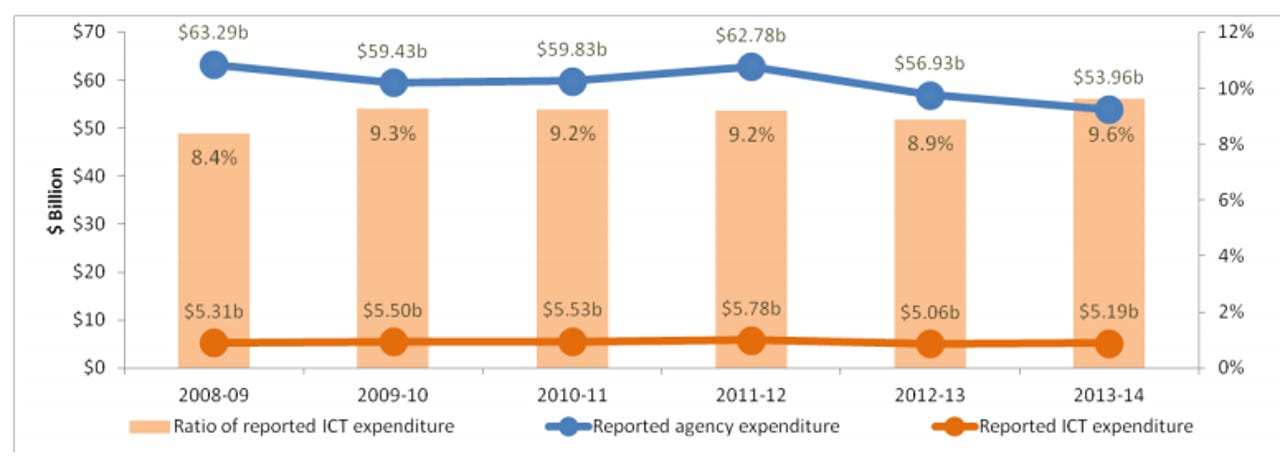Australian government IT spend rises amid public service cuts

From the 2008-09 financial year until 2013-14, over AU$9 billion was cut from the budgets of Australian government agencies, yet as a percentage of overall spending, IT rose from 8.4 percent to 9.6 percent, the department of finance said in Australian Government ICT Trends Report 2013-14 (PDF).
In absolute terms, over the same timeframe, spending rose steadily from AU$5.31 billion in 2008-09 to AU$5.78 billion in 2011-12 before dropping to a AU$5.06 billion nadir in 2012-13 before finally coming in at AU$5.19 billion in 2013-14, the last year covered in the report.
As a percentage of total spending by the Australian government, IT expediture has sat in a band between 1.2 to 1.4 percent.
The report showed that the government has taken to virtualisation with gusto, more than doubling the average number of operating system instances per physical server over the timeframe of the report, with a peak in 2012-13.
"In 2012-13 there was an anomalous rise in the virtualisation rate, driven by an unprecedented increase in the number of OSes," the report said. "In the context of the overall reporting period, the subsequent fall in the number of OSs, and the drop in the virtualisation rate, 2013-14 is a return to the trend established by the years 2008-09 to 2011-12."
At the same time, the report said the government's hunger for storage has continued at pace, with 33 petabytes of storage brought online each year, while the cost of storage has fallen from AU$4,379 per terabyte to AU$767.
Over the reporting period, usage of thin client devices tripled from 2 percent to 6 percent, with laptops making up a steady 14 percent of devices, and desktops declining from 83 percent to 80 percent.
Latest Australian news
Although the report showed that the Australian government was spending more on IT per employee than an average of international governments, AU$31,500 versus AU$23,000 over five years, the report warned that the result was likely skewed.
"These benchmarks should be viewed cautiously given the differences in the cost of wages, broadband connectivity, and software in Australia."
Over the timeframe covered in the report, the Australian government and its agencies have embraced cloud computing. In an edict brought down last year, the Department of Finance said government agencies would adopt cloud computing services the next time their systems were due for a refresh.
In June last year, the Australian Government Chief Technology Officer John Sheridan told ZDNet that government agencies were in no rush to move to the cloud, with many waiting for existing contracts to end.
"One of the challenges of understanding of where you might use a cloud procurement is to reflect on the fact that we're often in contract for things now, and you're not going to move into the cloud in the middle of a contract; you're going to wait until a contract reaches its end and then in accordance with the direction from government, evaluate cloud opportunities that meet that particular requirement, and use them if it is value for money to do so," he said.
The government has also established the Digital Transformation Office designed to make it easier for the public to deal with government online.
Speaking at the CEDA State of the Nation conference in Canberra on Monday, Department of Finance Secretary Jane Halton said agencies needed to be prepared to "cannibalise" their own systems and services, and be prepared to fund new systems and services through existing funding.
